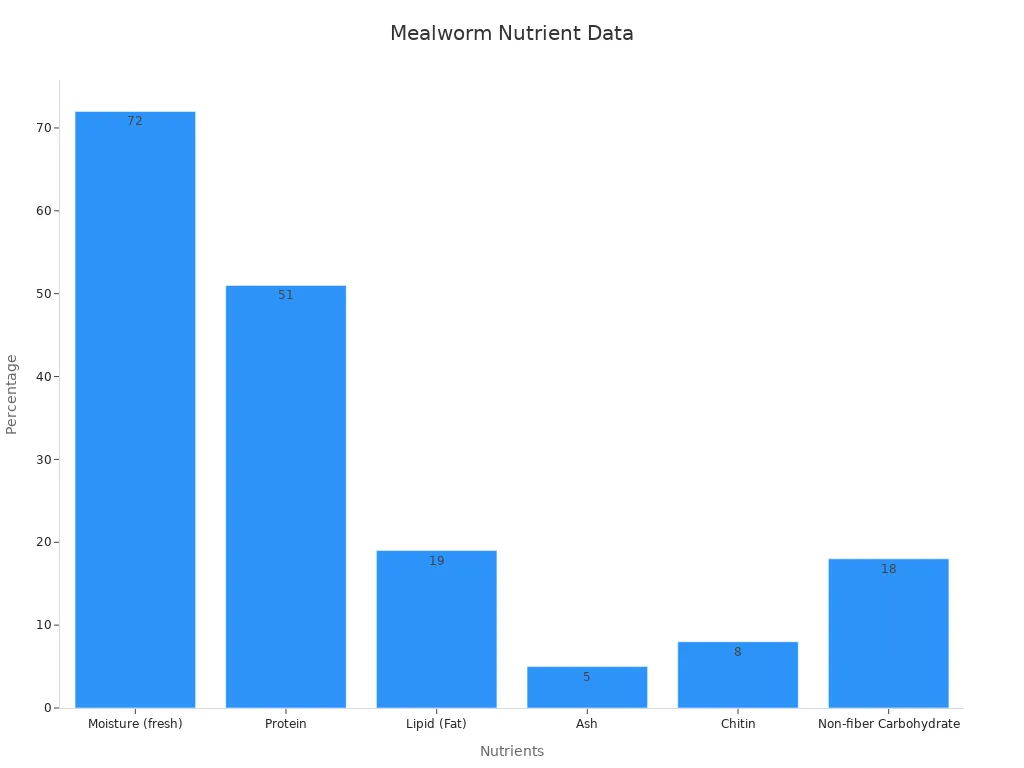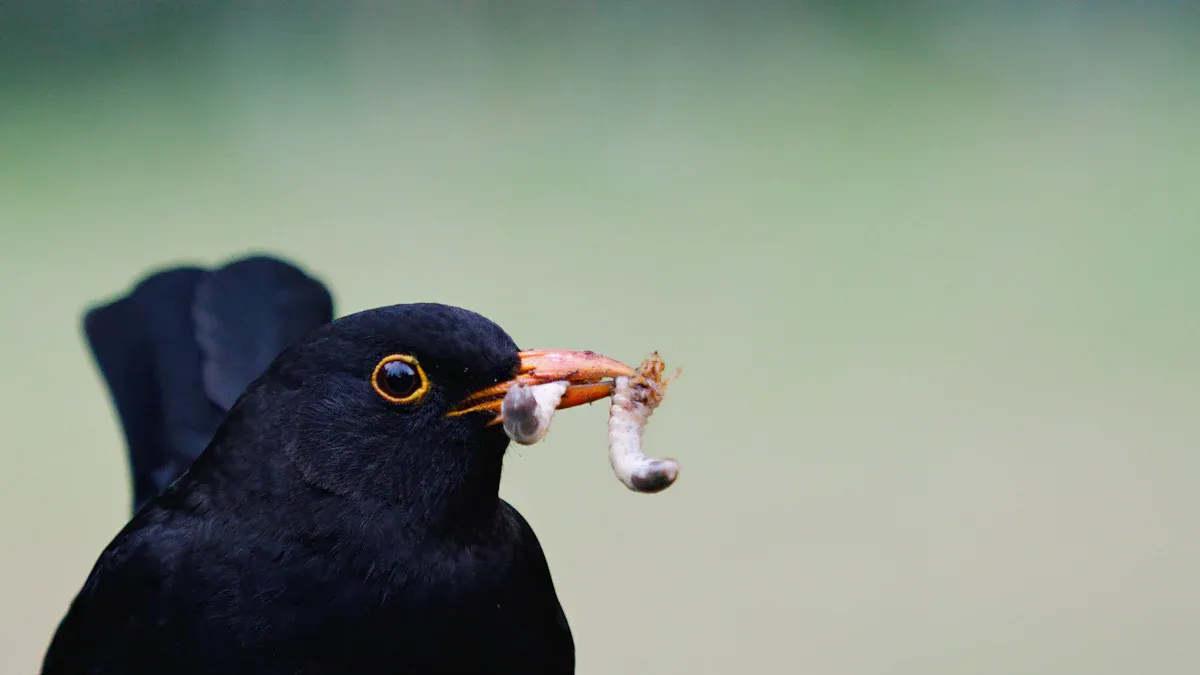
Bird seed mealworms give wild birds a tasty boost of protein and energy. Many birds love mealworms, so feeders often see new species visiting their yards. People who use mealworms with bird seed notice more activity and variety at their feeders. Birdwatching becomes even more fun.
Key Takeaways
- Mealworms provide wild birds with high protein and energy, helping them stay healthy and raise more chicks during breeding season.
- Adding mealworms to bird seed attracts a wider variety of birds, including insect-eating species like robins and bluebirds, making birdwatching more exciting.
- Use live or dried mealworms as treats alongside seeds, keep feeders clean and safe, and store mealworms properly to support bird health and prevent pests.
Nutritional Benefits of Bird Seed Mealworms

High Protein, Fat, and Fiber Content
Bird seed mealworms pack a powerful punch when it comes to nutrition. These tiny larvae offer a rich source of protein, healthy fats, and fiber. Birds need these nutrients to stay active and healthy. The protein in mealworms helps birds build strong muscles and feathers. Fat gives them energy, especially during cold weather or migration.
Here’s a quick look at the nutritional breakdown of mealworms:
| Nutrient Component | Percentage (Dry Matter Basis) |
|---|---|
| Protein | 46% to 52% |
| Fat | 19% to 35% |
| Crude Fiber | Variable |
| Moisture (fresh) | 60% to 72% |
| Ash | 5% |
| Chitin | 8% |
| Non-fiber Carbohydrate | 18% |

Mealworms also have a high protein digestibility rate, which means birds can easily absorb and use the nutrients. Innosentia’s Dried Mealworm Topping gives wild birds a hearty and flavorful treat that supports their daily needs.
Supporting Bird Health and Breeding
Birds need more than just seeds to thrive, especially during breeding season. Studies show that adding mealworms to a bird’s diet can boost their health and help them raise more chicks. For example, research by Harrison and colleagues found that food supplements like mealworms improve breeding productivity in many bird species. Another study by Peach and his team showed that house sparrows raised more chicks when they had access to mealworms. Bailey and Bonter also discovered that bluebirds with extra mealworms started nesting earlier and had better nest survival.
When birds get enough protein and energy, they can lay more eggs and care for their young. Bird seed mealworms make it easier for parent birds to feed their chicks, leading to healthier families and more birds in your yard.
Tip: Offering mealworms during spring and summer can give nesting birds the extra boost they need for a successful breeding season.
Complements Traditional Bird Seed
Bird seed mealworms work well with regular bird seed. Seeds provide important vitamins, minerals, and carbohydrates, while mealworms add extra protein and fat. This combination gives birds a balanced diet that supports growth, energy, and immune health.
- Mealworm meal in bird diets improves body weight gain and feed efficiency.
- Adding mealworms can reduce the need for other protein sources like soybean meal, without lowering performance.
- Birds fed mealworms show stronger immune systems and better digestive health.
- Mealworm proteins are highly digestible and offer all the essential amino acids birds need.
By mixing mealworms with traditional seed, bird enthusiasts can help their feathered friends stay healthy and active all year long. Many backyard birdwatchers notice that their feeders attract a wider variety of birds when they offer both seeds and mealworms.
Attracting More Birds with Bird Seed Mealworms

Appealing to Insect-Eating Species
Many birds love insects, especially those that eat bugs as their main food. When someone adds bird seed mealworms to their feeders, they invite these insect-eating birds to visit. Mealworms look and taste like the insects birds find in nature. This makes them a favorite treat for birds that might not come for seeds alone.
Did you know? Scientists have seen more birds around feeders with mealworms. In one study, woodland feeders had fewer mealworms left because birds ate them so quickly. This shows that insect-eating birds really enjoy mealworms.
Examples of Birds Attracted by Mealworms
Bird seed mealworms attract a wide range of species. Some birds that love mealworms include:
- Wrens
- Grosbeaks
- Warblers
- Bluebirds
- Mockingbirds
- Robins
- Brown Thrashers
- Chickadees
- Red-breasted and White-breasted Nuthatches
- Jays
- Small woodpeckers, like Red-bellied Woodpeckers
Robins often take mealworms to feed their babies. Bluebirds also carry mealworms back to their nests. Even birds in rehabilitation centers eat mealworms to help them get strong again.
Enhancing Backyard Bird Diversity
Adding mealworms to feeders does more than just attract a few new birds. It brings a whole new level of excitement to birdwatching. People often see birds they have never spotted before. The mix of seeds and mealworms can turn a backyard into a busy spot for many different species. This variety makes birdwatching more fun and helps support a healthy bird community.
How to Feed Bird Seed Mealworms
Live vs. Dried Mealworms
Bird lovers often wonder if live or dried mealworms work best. Live mealworms move around, which can make birds more excited and encourage natural foraging. Studies show that live larvae help birds like hens and ducks improve their feather condition and spend more time exploring. Birds also show less stress and aggression when they eat live mealworms. Dried mealworms, on the other hand, are easier to store and serve. They do not spoil as quickly and still offer a good source of protein, but they may not boost bird activity as much as live ones.
Mixing and Serving Tips
Feeding bird seed mealworms is simple with a few tips:
- Offer mealworms as a treat, not the main food.
- Give dried mealworms in small amounts, maybe as an afternoon snack.
- Mix in fresh greens or vegetable scraps for extra nutrition.
- Try moistening dried mealworms to make them more appealing.
- Adjust the amount during breeding season when birds need more protein.
Feeder Types and Placement
Choose feeders that keep mealworms from escaping or spoiling. Tray feeders, dish feeders, and covered platforms work well. Place feeders in quiet spots with some cover, like near bushes or trees. This helps birds feel safe while they eat.
Maintenance and Cleanliness
Clean feeders at least once a week with a 10% bleach solution, then rinse and dry them well. Remove old food and droppings every day to stop bacteria and mold from growing. Moving feeders now and then can help prevent disease and keep birds healthy.
Addressing Common Concerns with Bird Seed Mealworms
Preventing Pests and Unwanted Visitors
Many people worry about attracting pests when they feed birds. However, research shows that feeding wild birds can actually help control pests. When birds gather at feeders, they eat more insects like mealworms and aphids. This reduces the number of pests in the area. In orchards, birds preyed on over 94% of mealworm stations, showing their strong role in pest control. By encouraging birds to visit, people can help keep their yards healthier and reduce the need for pesticides.
| Factor | Observation | Implication for Pest Prevention with Bird Seed Mealworms |
|---|---|---|
| Predation by birds | Birds preyed on 94.1% of stations in orchards (net-free) and predation increased with distance into orchard | Promoting bird activity inside orchards enhances pest control |
| Supplementary feeding of birds | Feeding wild birds increases local bird densities, indirectly reducing arthropod pests | Bird feeding practices can enhance natural pest control |
Proper Storage Solutions
Keeping mealworms fresh and safe is important. Studies recommend storing dried mealworms in cool, dry places using sealed, opaque packaging. This keeps out moisture and light, which can spoil the food. The best storage keeps the moisture content below 6% and water activity under 0.50. These steps help prevent mold and keep the protein and fat in mealworms stable. Innosentia’s Dried Mealworm Topping comes in packaging designed to protect freshness and nutrition, making it easy for bird lovers to store and serve.
Keeping Feeders Safe and Accessible
Safe feeders help birds stay healthy. People should place feeders near bushes or trees for cover, but also in open spots so birds can watch for predators. Hanging feeders five to six feet above the ground keeps them out of reach of most pests. Using baffles or cages can stop squirrels and raccoons from stealing food. Cleaning feeders often with hot water and letting them dry before refilling helps prevent mold and disease. Placing feeders away from windows also protects birds from collisions. These simple steps make feeding birds safe and enjoyable for everyone.
Bird lovers see big rewards when they add mealworms to their feeders.
- Mealworms boost chick survival and bird health.
- They attract new species like chickadees and robins.
- Dried mealworms offer easy, year-round feeding.
Trying bird seed mealworms can turn any backyard into a lively bird haven.
FAQ
Can birds eat dried mealworms every day?
Yes, birds can enjoy dried mealworms daily. They add protein and energy. Innosentia’s Dried Mealworm Topping makes a great treat for wild birds all year.
Will mealworms attract unwanted animals?
Most birds eat mealworms quickly, so pests rarely get a chance. Place feeders high and use baffles to keep squirrels and raccoons away.
How should someone store dried mealworms?
Store dried mealworms in a cool, dry place. Use sealed packaging. This keeps them fresh and safe for birds. Innosentia’s packaging helps protect quality.


